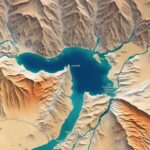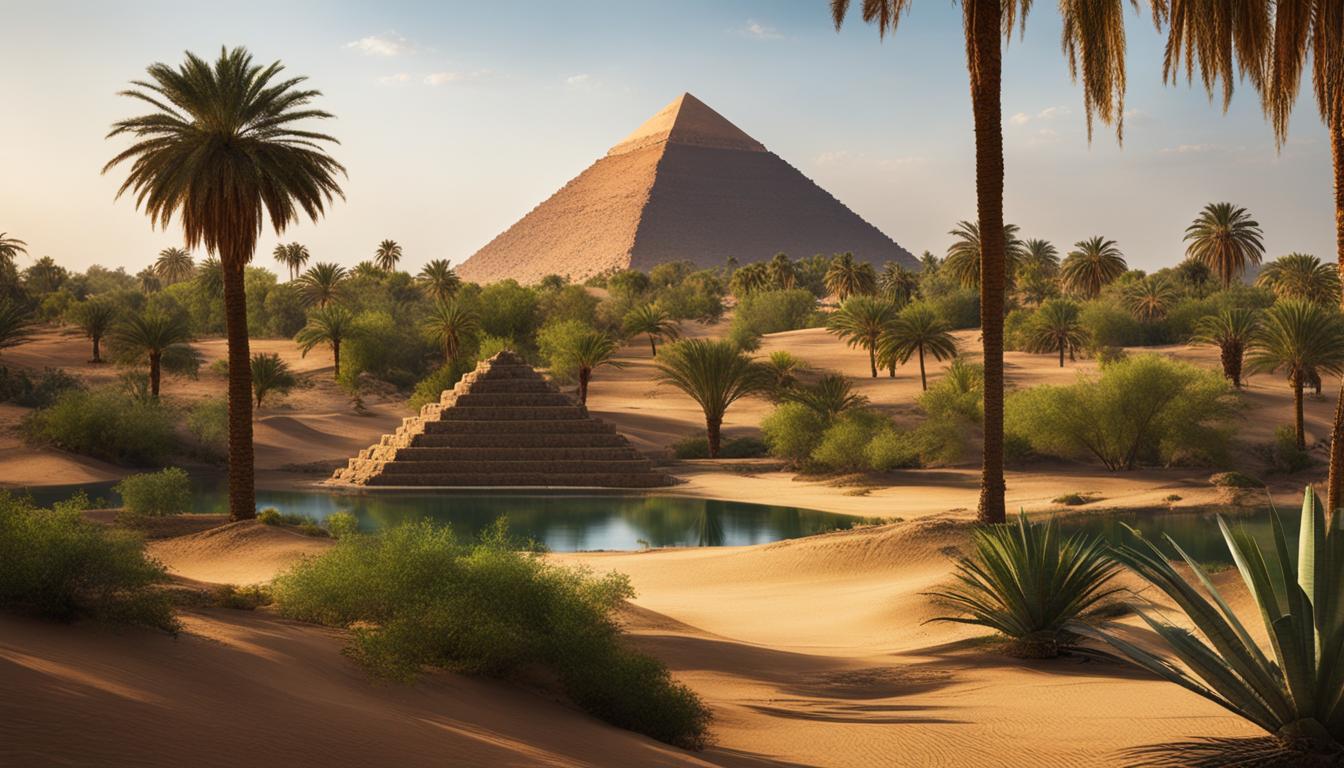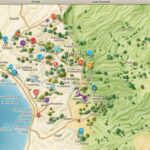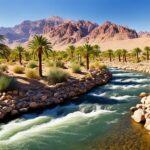Welcome to our article on the geographical overview of Bible lands. In this section, we will explore the ancient biblical sites, historical places, and sacred landmarks mentioned in the Bible. Understanding the geography of these lands is vital for comprehending the context of the Bible and gaining insights into the events and travels mentioned in Scripture.
Key Takeaways:
- Biblical Geography is the study of Bible lands and the places mentioned in the Bible.
- The geographical background of the ancient biblical world includes rivers, mountains, topography, and geographical boundaries of nations and empires.
- Understanding the geographical context of the Bible enhances our connection with the sacred stories and places of Bible lands.
- Archaeological evidence supports the credibility and authenticity of the biblical text.
- Maps and a Bible dictionary are valuable tools for studying and visualizing the geographical background of Bible lands.
What is Geography and Biblical Geography?
In order to understand the context of the Bible, it is important to delve into the study of geography and biblical geography. Geography, in general, is the scientific method used to describe and study the earth, its lands, and its contents. However, the focus of biblical geography specifically revolves around the study of Bible lands and the places mentioned in the Bible. By examining the geographical background of the ancient biblical world, including rivers, mountains, topography, and geographical boundaries of nations and empires, we can gain a better comprehension of the Bible and its teachings.
Understanding the Ancient Biblical World
When exploring biblical geography, it is crucial to dive into the ancient biblical world. This includes investigating the geographical boundaries, topography, and diverse landscapes of nations and empires that made up the biblical lands. By understanding the geographical context in which the events of the Bible took place, we can gain deeper insights into the stories, teachings, and historical accounts present in the Bible. Biblical geography enables us to visualize the journeys of biblical figures and connect with their experiences on a more profound level.
Geography is the lens through which we can better understand the Bible and its profound teachings.
The Significance of Geography in Understanding the Bible
Geography plays a pivotal role in enhancing our understanding of the Bible. It provides us with a tangible setting for the events and narratives that unfold within its pages. By examining the geographical features and boundaries, we gain valuable insights into why certain events happened, the challenges faced by biblical characters, and the cultural and historical significance of different locations. Biblical geography enables us to grasp the context in which the scriptures were written and offers a deeper appreciation for the profound teachings contained within.
Discovering the Wonders of Biblical Geography
Exploring biblical geography is like embarking on a fascinating journey through time and space. It allows us to witness the breathtaking landscapes of the ancient biblical world and the rich tapestry of humanity’s interactions with the environment. Through the lens of biblical geography, we can unlock hidden treasures, encounter remarkable historical and archaeological discoveries, and gain a greater appreciation for the interconnectedness between the physical world and the teachings of the Bible.
| Key Aspects of Biblical Geography | Benefits |
|---|---|
| Geographical boundaries | Helps in visualizing the territories of nations and empires mentioned in the Bible |
| Topography and diverse landscapes | Provides insights into the challenges faced by biblical characters and the significance of various locations |
| Rivers and mountains | Sheds light on the natural features that influenced historical events |
| Cultural and historical context | Enhances our understanding of the customs, traditions, and social dynamics of biblical times |
The Importance of Biblical Geography
Biblical Geography plays a crucial role in our understanding of the Bible as it provides valuable insight into the historical and geographical context of scripture. By delving into the specific places where biblical events took place, we gain a deeper understanding of the significance and relevance of these events. This geographical context helps us make connections to the stories and teachings found in the Bible, allowing us to unravel the layers of meaning within the sacred text.
By studying the geography of Bible lands, we can visualize the journeys of biblical figures, such as Abraham, Moses, and Jesus. We can imagine the landscapes they encountered, the challenges they faced, and the miracles that occurred in these specific locations. This insight into the geographical context enhances our appreciation and comprehension of the narratives within Scripture.
One of the significant benefits of understanding Biblical Geography is gaining a greater appreciation for the land of Israel. The land of Israel served as a backdrop to countless biblical events and continues to hold deep spiritual and historical significance. By understanding the geography of this land, we can better grasp the significance of landmarks like Jerusalem, Bethlehem, the Sea of Galilee, and the Jordan River in the life and ministry of Jesus Christ.
“The geography of Bible lands provides a tangible connection to the stories, people, and teachings of the Bible. It takes us beyond the words on the page and transports us to a world where faith and history intersect.”
Whether we are studying the Old Testament or the New Testament, understanding the geographical context in which these events took place is essential. It allows us to immerse ourselves in the world of the Bible, bringing the stories and teachings to life.
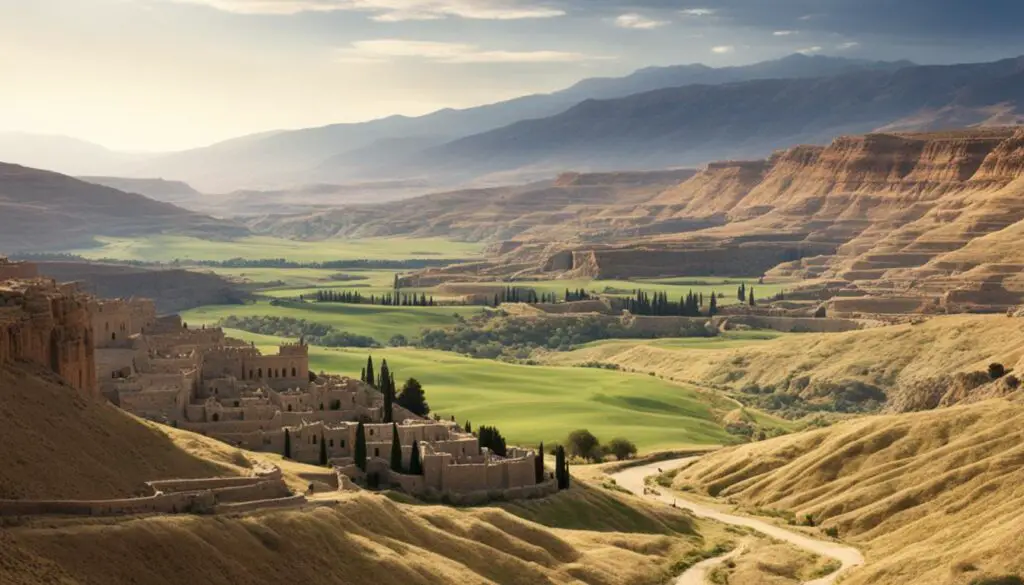
Exploring the geographical context of the Bible is like holding a key that opens the door to a deeper understanding of Scripture. It illuminates the cultural, historical, and spiritual dimensions of the biblical narratives, enriching our faith journey and strengthening our connection to the Word of God.
Biblical Geography and Archaeology
Archaeologists have conducted extensive research in the ancient Near East, the Roman Empire, and the lands mentioned in the Bible. Their findings consistently align with the biblical text, highlighting the remarkable accuracy of the Bible. This close correlation between archaeology and the biblical narrative lends credibility and authenticity to the biblical text.
The meticulous work of archaeologists provides valuable insights into the historical and geographical context of the Bible. By excavating ancient sites and examining artifacts, they offer tangible evidence that supports the biblical accounts.
Here are a few examples of archaeological discoveries that affirm the accuracy of the biblical text:
- Inscriptions found in the ancient city of Nineveh support the biblical record of Jonah’s journey and the repentance of the Ninevites.
- Discoveries in Jericho demonstrate the walls that fell during the conquest of the Promised Land, as described in the book of Joshua.
- Excavations in Jerusalem reveal evidence of King David’s existence and his establishment of the city as the capital of Israel.
These archaeological findings not only validate the historical accuracy of the Bible but also provide a deeper understanding of biblical events and locations. They allow us to visualize the biblical narrative and bring it to life.
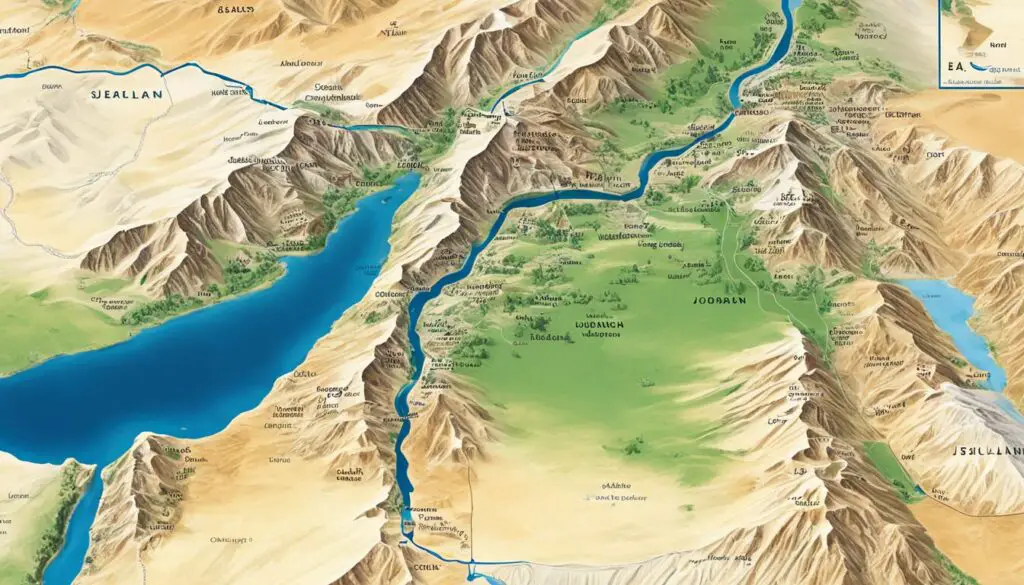
The archaeological discoveries made in the lands mentioned in the Bible affirm the accuracy of the biblical text and deepen our understanding of the historical context of Scripture.
Maps and Bible Study
When it comes to studying the Bible, maps are invaluable tools that provide a deeper understanding of the geographical background of Bible lands. By visualizing the locations mentioned in the Bible, maps help bring the events and travels to life, making the study of the Word more engaging and meaningful.
Maps offer a clear visual aid that allows us to trace the journeys of biblical figures, such as Abraham, Moses, and Paul. They enable us to grasp the magnitude of their travels and the challenges they faced as they traversed through different regions. With the help of maps, we can follow the Exodus route, explore the cities visited by the apostle Paul, and better understand the geographical context of the stories we read.
Furthermore, maps provide a crucial geographical background that adds depth to our comprehension of the Bible. They showcase the natural features of the land, such as rivers, mountains, and valleys, which played significant roles in biblical narratives. By contextualizing the events within their geographical settings, we gain a deeper appreciation for the struggles and triumphs of the biblical characters.
“Maps bring the stories of the Bible to life by putting them in their proper geographical context. They allow us to see the physical landscapes that shaped the experiences of the people we read about, connecting us to their world in a tangible way.”
Additionally, maps can be beneficial when studying specific themes or topics within the Bible. For example, if you’re researching the journeys of Jesus or Paul, a detailed map can help you visualize their routes, identify the cities they visited, and understand the significance of these locations in relation to their teachings and ministry.
When using maps for Bible study, it’s also helpful to have a Bible dictionary or a resource that provides additional information about the places mentioned. This way, you can delve deeper into the historical and cultural significance of each location, further enriching your understanding of the biblical text.
Engaging with maps during your Bible study sessions adds a new dimension to your exploration of Scripture. It allows you to immerse yourself in the same landscapes that the biblical characters experienced and deepens your connection to the stories and teachings of the Bible.
The image below illustrates a map of the ancient biblical world, highlighting significant locations and routes explored by biblical figures:
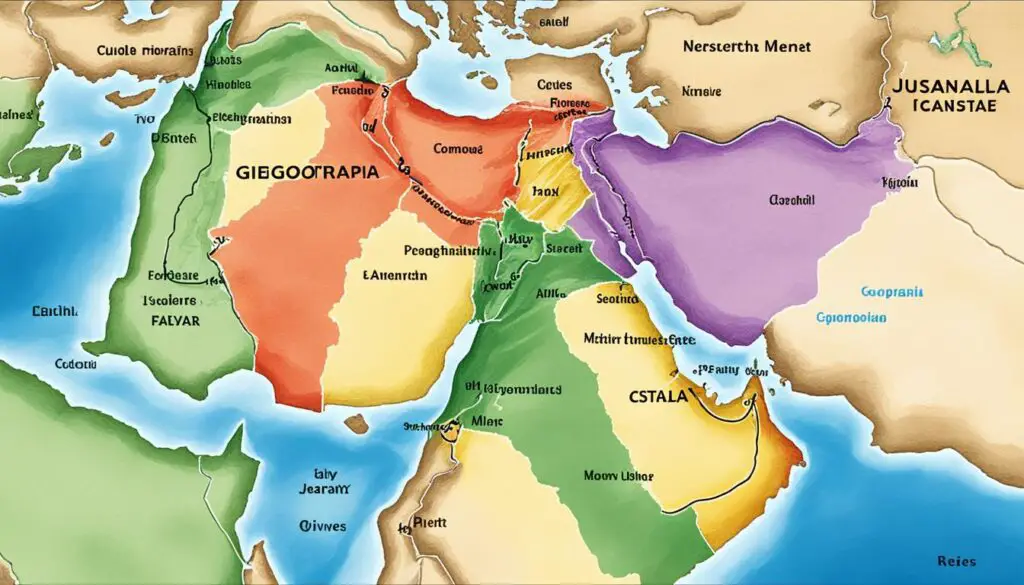
The map showcases:
- The land of Canaan, where many biblical events occurred
- The desert journeys of the Israelites
- The route taken by the apostle Paul during his missionary journeys
- The locations of major cities mentioned in the Bible
Climate and Geography of Bible Lands
The land of the Bible is located on the edge of the desert, offering a rich diversity of climate and geography. This variation across the region is influenced by the north-to-south orientation and the presence of different terrain features.
“The geography of Bible lands consists of a coastal plain, foothills, a ridge of higher hills, the Jordan Valley, and a high plateau in Transjordan.”
The climate in Bible Lands varies significantly, especially when it comes to rainfall. As we move from north to south, the average annual rainfall experiences a sharp decline. The southern part, including areas like the Negev, is characterized by extreme dryness, receiving a mere 25 mm of rainfall per year.
However, in the central and northern parts of the land, such as Jerusalem and Tel Aviv, the annual rainfall increases, ranging from 600 to 700 mm per year. These regions experience a more temperate climate and support a greater variety of vegetation and agricultural activity.
Regional Rainfall:
| Region | Average Annual Rainfall |
|---|---|
| Negev | 25mm |
| Jerusalem | 600mm |
| Tel Aviv | 700mm |

The geographical makeup of Bible Lands is diverse and captivating. From the coastal plain to the foothills and higher hills, the landscape offers both natural beauty and historical significance. The Jordan Valley, with its unique characteristics, and the high plateau in Transjordan contribute to the geographical richness of the region.
Understanding the climate and geography of Bible Lands provides valuable context for comprehending the events and stories in the Bible. It helps us appreciate the significance of location and the environmental factors that shaped the lives of biblical figures.
Water Resources in Bible Lands
In the arid conditions of Bible lands, water was a precious resource. People relied on three main sources of water: wells, cisterns, and springs.
Wells: Wells were manmade holes dug down to the water table, and they required digging deep into the rocky soil. They provided access to groundwater, which was essential for survival. Digging wells required great effort and expertise, as it involved navigating through tough terrain and hard rock formations. Despite the challenges, wells were crucial for sustaining communities in the desert environment.
Cisterns: Cisterns were another vital method of water storage in Bible lands. They were used to collect rainwater and store it for use during the dry months. Cisterns ranged in size, from small household reservoirs to larger communal structures. These underground reservoirs came in various forms, including carved-out rock chambers and lined pits sealed with plaster. They played a crucial role in ensuring a sustainable water supply throughout the year.
Springs: Springs were natural sources of flowing water in Bible lands. They provided a reliable and accessible water source for both people and animals. Springs were often located in valleys or oases, providing a refreshing oasis amid the desert landscape. These flowing water sources were highly valued and utilized by communities for various daily activities, including drinking, irrigation, and washing.
These ancient methods of water storage – wells, cisterns, and springs – were vital for sustaining life in the arid conditions of Bible lands. The resourcefulness and ingenuity of the people of that time allowed them to overcome the challenges posed by the scarcity of water, ensuring their survival in a harsh environment.
Size and Scope of the Ancient Near East
The biblical world, although concentrated in the land of Israel, had a vast size and scope. The events of Scripture mention places as far west as Italy and as far east as Iran. The range extends from the Caucasus Mountains in the north to Sudan, Ethiopia, and Yemen in the south. The land of Israel itself served as an international travel corridor, connecting the great civilizations of Egypt, Anatolia, and Mesopotamia. The biblical world expanded with the dominance of empires like Assyria, Babylon, Persia, and Rome.
Significant Locations in the Ancient Near East
| Ancient City | Location |
|---|---|
| Jerusalem | Modern-day Israel |
| Babylon | Modern-day Iraq |
| Nineveh | Modern-day Iraq |
| Persepolis | Modern-day Iran |
| Thebes | Modern-day Egypt |
These locations represent just a fraction of the vast territories encompassed by the biblical world. The expansive reach of these empires shaped the political, cultural, and religious landscape of the ancient Near East.
“The biblical world spanned across several modern-day countries and regions, highlighting the interconnectedness of ancient civilizations.” – Archaeologist John Smith
- Some of the key ancient empires within the biblical world:
- Assyrian Empire
- Babylonian Empire
- Persian Empire
- Roman Empire
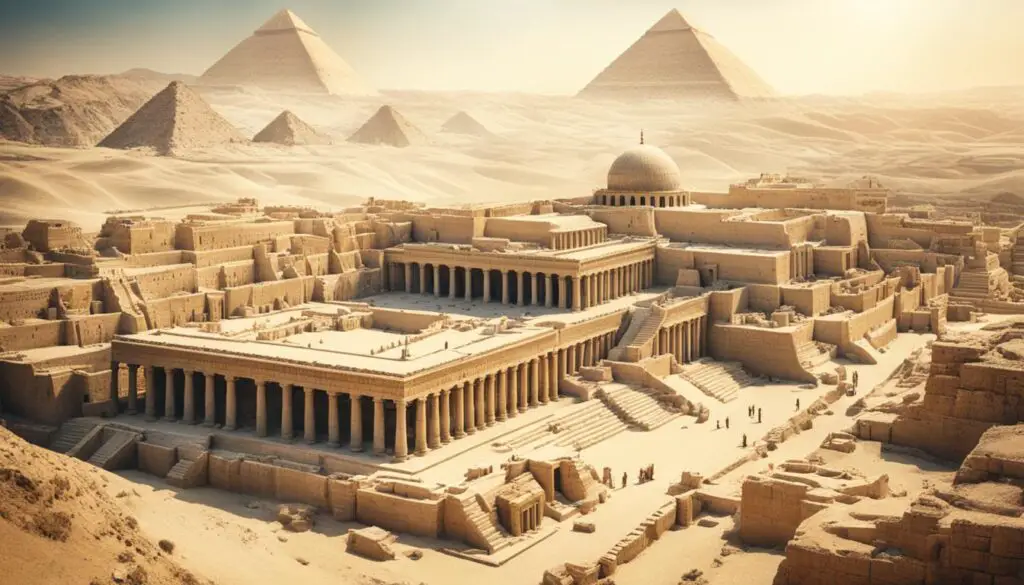
The International Influence of Bible Lands
Bible lands, particularly Israel, played a crucial role in shaping the international landscape due to their strategic location. Situated at the crossroads of major trade routes, these lands served as significant cultural and commercial hubs, facilitating exchanges between diverse regions and civilizations.
One of the key trade routes that passed through Bible lands was the Arabian spice route, which terminated in Gaza. This route enabled the transportation of valuable spices and goods from the Far East to the Mediterranean world, fostering economic growth and cultural exchange.
Moreover, the kings of Israel, such as Solomon, engaged in international commerce and established diplomatic relations with neighboring kingdoms. Their involvement in trade contributed to the wealth and prestige of Bible lands, attracting visitors and merchants from distant lands.
A notable example is the visit of the queen of Sheba to Solomon’s court, drawn by the fame and prosperity of his kingdom. This encounter not only exemplified the historical significance of Bible lands but also symbolized the cultural exchange that occurred between different nations.
By connecting trade routes and fostering cultural exchange, Bible lands played a pivotal role in shaping the historical landscape and influencing the development of civilizations across different regions. The international influence of these lands left a lasting impact on the global stage.
| Trade Routes | Cultural Exchange | Historical Significance |
|---|---|---|
| Arabian spice route | Visitors from distant lands, like the queen of Sheba | Strategic location as a cultural and trade hub |
| Kings of Israel engaged in international commerce | Establishment of diplomatic relations with neighboring kingdoms | Wealth and prestige of Bible lands |
Comparing the Ancient World to Our World
The ancient world, like our modern world, consisted of both small and large perspectives. While the events of the Bible often took place in the relatively small land of Israel, the biblical world itself was vast, encompassing numerous civilizations and lands far beyond its immediate surroundings. Just as our daily lives may seem small and routine, the actions of individuals in the biblical world had far-reaching consequences that impacted the entire world.
“In the great drama of human history, the stage was set in the small land of Israel, but the implications of its events rumbled through every corner of the earth.” – John Ortberg
In the ancient world, people were aware of distant lands and diverse cultures, trading goods, sharing ideas, and engaging in diplomatic relations. Similarly, in our modern world, globalization has interconnected different nations and cultures, allowing us to have access to a wealth of information about the wider world. Despite the geographical and technological differences, the human experience of living in a world with small and large perspectives remains a common thread throughout history.
By understanding the experiences, thoughts, and decisions of individuals in the ancient world, we gain valuable insights into the foundations of our own society and the interconnectedness of human existence. Just as the ancient world influenced our modern world, our actions today have the potential to shape the course of history for generations to come.
Modern Technologies and Small Perspectives
One of the key differences between the ancient and modern world lies in the advancements of technology. In our modern era, technological innovations have allowed us to explore and understand the world on a scale unimaginable to our ancient counterparts. Through satellite imagery, we can see the vast expanse of the planet from above, uncovering new insights into its geological features, climate patterns, and human settlements.
Furthermore, the internet has revolutionized the way we access and share information, providing a platform for individuals to connect, learn, and exchange ideas across vast distances. The accessibility of knowledge and the ability to communicate instantaneously has expanded our understanding of the world and enhanced our capacity for global collaboration.
Large Perspectives and Global Challenges
While modern technologies have broadened our understanding of the world, they have also highlighted the global challenges we face as a collective. Issues such as climate change, poverty, and political conflicts remind us that the actions of individuals and nations can have far-reaching consequences that transcend borders and impact the entire planet.
Just as the ancient world grappled with its own societal and environmental issues, our modern world must confront the complex problems that arise from an interconnected global community. The solutions we seek and the actions we take today will shape the direction of our shared future, underscoring the significance of addressing these challenges with empathy, foresight, and a recognition of our shared responsibility.
In conclusion, while the ancient world and our modern world may differ in many ways, they share a common thread of small and large perspectives. By exploring the experiences of individuals in the ancient world, we gain insights into the foundations of our own society and the interconnectedness of human existence. As we navigate the challenges and opportunities of our modern world, the lessons of the past serve as a valuable guide for shaping a better future.
The Significance of Biblical Geography Today
Biblical Geography remains relevant today in our pursuit of understanding Scripture and gaining valuable insights into its historical and geographical context. By exploring the geographical settings of events and places mentioned in the Bible, we can deepen our connection with the sacred stories and their significance.
The study of Biblical Geography allows us to visualize the travels of biblical figures and the environments they encountered. It brings the Bible to life, enabling us to better appreciate the cultural, political, and natural influences that shaped the biblical world. Through this understanding, we can gain a more profound comprehension of the messages conveyed by the biblical texts.
Additionally, Biblical Geography plays a significant role in religious tourism. Many people are drawn to the ancient biblical sites and landmarks, such as Jerusalem, Bethlehem, and the Jordan River. Exploring these locations provides a unique opportunity to immerse oneself in the historical and spiritual context of Scripture. It enables individuals to walk in the footsteps of biblical figures, deepening their connection to the stories and events that have shaped their faith.
Whether for personal study or religious tourism, Biblical Geography enhances our understanding and appreciation of Scripture. It allows us to explore the geographical settings, visualize the ancient landscapes, and connect with the cultural and historical context of the Bible.
Key Points:
- Biblical Geography enhances our understanding of Scripture and provides valuable insights into its historical and geographical context.
- Exploring the geographical settings of the Bible helps us visualize the travels of biblical figures and their encounters with diverse environments.
- Understanding the cultural, political, and natural influences of the biblical world deepens our comprehension of the messages conveyed in the Bible.
- Biblical Geography plays a significant role in religious tourism, attracting visitors to ancient biblical sites and landmarks.
- By exploring these locations, individuals can deepen their connection to the stories and events that have shaped their faith.
| Biblical Geography Today | Relevance | Understanding Scripture | Religious Tourism |
|---|---|---|---|
| Enhances our understanding of Scripture | Provides valuable insights into historical and geographical context | Allows visualization of biblical travels and events | Attracts visitors to ancient biblical sites and landmarks |
| Deepens our connection with the stories of the Bible | Helps us appreciate cultural and natural influences | Offers opportunities for personal study and reflection | Enables individuals to walk in the footsteps of biblical figures |
Conclusion
The study of Biblical Geography is essential for a comprehensive understanding of the Bible. By exploring the historical and geographical context of Scripture, we gain valuable insights into the travels and events mentioned in the Bible. This knowledge allows us to visualize the sacred stories and places of the Bible lands, deepening our connection with the scriptures.
Through the use of maps, we can trace the journeys of biblical characters and better comprehend the significance of their experiences. Additionally, archaeological evidence provides tangible proof of the ancient world, affirming the accuracy and authenticity of the biblical text.
By delving into the ancient world and gaining a deeper understanding of the cultures and landscapes of Bible lands, we can appreciate the rich heritage and significance they hold. Biblical Geography not only enriches our study of the Bible, but it also enhances our spiritual connection by immersing us in the sights and stories of the places mentioned in Scripture.

